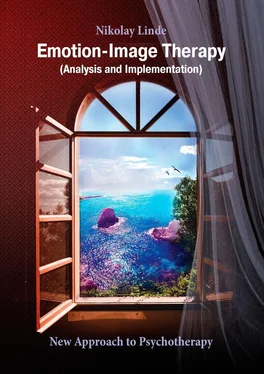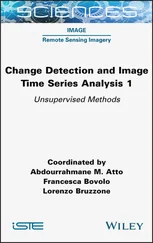Nikolay Linde - Emotion-Image Therapy. Analysis and Implementation
Здесь есть возможность читать онлайн «Nikolay Linde - Emotion-Image Therapy. Analysis and Implementation» — ознакомительный отрывок электронной книги совершенно бесплатно, а после прочтения отрывка купить полную версию. В некоторых случаях можно слушать аудио, скачать через торрент в формате fb2 и присутствует краткое содержание. ISBN: , Жанр: Здоровье, psy_generic, на английском языке. Описание произведения, (предисловие) а так же отзывы посетителей доступны на портале библиотеки ЛибКат.
- Название:Emotion-Image Therapy. Analysis and Implementation
- Автор:
- Жанр:
- Год:неизвестен
- ISBN:9785449698827
- Рейтинг книги:5 / 5. Голосов: 1
-
Избранное:Добавить в избранное
- Отзывы:
-
Ваша оценка:
- 100
- 1
- 2
- 3
- 4
- 5
Emotion-Image Therapy. Analysis and Implementation: краткое содержание, описание и аннотация
Предлагаем к чтению аннотацию, описание, краткое содержание или предисловие (зависит от того, что написал сам автор книги «Emotion-Image Therapy. Analysis and Implementation»). Если вы не нашли необходимую информацию о книге — напишите в комментариях, мы постараемся отыскать её.
Emotion-Image Therapy. Analysis and Implementation — читать онлайн ознакомительный отрывок
Ниже представлен текст книги, разбитый по страницам. Система сохранения места последней прочитанной страницы, позволяет с удобством читать онлайн бесплатно книгу «Emotion-Image Therapy. Analysis and Implementation», без необходимости каждый раз заново искать на чём Вы остановились. Поставьте закладку, и сможете в любой момент перейти на страницу, на которой закончили чтение.
Интервал:
Закладка:
You can’t say about such person that he lacks in character because a weak-willed person displays weak unstable and dependable character. A non-character person can easily stand up for justice and can’t be easily bent to someone’s will because he has an independent character. He doesn’t live inside his character, his character doesn’t command how he should live, he rules over his character if he still has some stereotype reactions. So he is always different and you can’t say what stable features of character he has. The only suitable term to describe him is “non-character” that is not corresponding to traditional classifications of characters, flowing like water he reacts not in keeping with the character but freely as it is necessary here and now.
Character is stiff and stuck emotions turned to stone in the forms if muscle clamps or ousted and materialized in the forms of emptiness and muscle impotence. Very often current problems of a personality are the result of deeper defects of character. As we have already said people face the problems which reflect our character. The world gives us back our own reflection exactly like it did for the famous donkey Eeyore. As we know he looked at his reflection on one side of the lake, then went to the other side looked again… “Yes, -he said, -I knew, on this aide it is no better than on that. Harrowing sight…” For some reason, people don’t think that it is necessary to change themselves, thinking that it is the world that is wrong and must be changed. But changing the world they face themselves again, fatally facing the consequences of their character, to which they try to adjust the world. The same thing happens when social revolutions take place.
The problem is that when we speak about changing the character practically any client demonstrates strong resistance. The matter is that he views himself as his character, he identifies himself with his character and is afraid of losing himself as a result therapeutic changes. Character is also connected with main life values and scenarios, supported by some inner philosophy, profound convictions, individual life experience. At the background of character there is some basic emotional fixation from early childhood, but the client is reluctant to change it in justified fear that he can lose the whole customary system relying on which he lived all his life. He fears to be unprotected in the face if unpredictable life.
If we manage to change some basic emotional fixation, the client may feel disoriented, as if he got into absolutely different unusual world and doesn’t know how to behave.
Example 3. “A new world”
Once I succeeded to help one student to get rid of bitterness that overfilled him. He had every reason to feel bitter he had to go through very much, but bitterness interfered in his life and studies, made all he was doing more difficult. I recommended him to go to the forest and shout there letting his anger go out. To my surprise he followed my advice he was shouting for two hours and kicking something in the air. And after this process he came somewhat soft and light.
– How is life? – I asked him.
– Excellent. Very calm. So many problems went away! I have enough time for everything, it is easier for me to study, have far less conflicts. But I just don’t know how to live this way?
– Why, isn’t it better?
– It is, but I don’t know how, I can’t live this way, it is sort of unusual…
– And what is wrong, give an example?
– My dad yelled at me and I don’t know what to tell him. Just sitting saying nothing… But actually he also got silent…
– Well, that’s fine, isn’t it?
– Yes, it is. But I don’t know how to live this way! These days on my way home I see two men fighting. In the past I would interfere in the fight, and now I think: What are they fighting for, fools and fools… I just passed them by. But I don’t know how to live this way!
I had to explain to him for a long time how to adapt to the new reality. He really began to study well, later entered a postgraduate course, though he had been a very poor student before. But I still had to work with him a lot.
Now let’s get back to the Wilhelm Reich theory. He discovered relatively independent segments of the muscle armor. Each one blocks some emotions. We use this information in EIT to diagnose what caused different psychological problems.
1. Eyes. Protective armor in eyes area reveals itself in brow immobility and “empty” expression of the eyes. They look as if from behind a motionless mask. You can achieve relaxation by opening your eyes as wide as possible [like you do in great fear] to move eyelids and brow to an enforced emotional state, as well as by rolling your eyes and looking from side to side fixing your look on either wall.
2. Mouth. Oral segment includes muscles of the chin, throat and the back of the head. The jaw can be both greatly compressed and unnaturally relaxed. This segment keeps the emotional expression of weeping, yelling, anger, biting, sucking, grimacing. Protective tensions can be relaxed by imitating weeping, making sounds engaging lips, making biting movements, throwing up movements and directly working on muscles.
3. Neck. This segment includes deep muscles of the neck and tongue. It controls mostly anger, yelling and weeping. It is not possible to directly affect deep muscles in the neck, so important means to achieve relaxation are yelling, screaming, vomiting movements and so on.
4. Breast. Breast segment includes broad muscles of shoulders, shoulder blades, thorax, arms and hands. This segment holds back laughter, anger, sorrow, passion. Holding back breathing, which is an important way of suppressing any emotion, is mostly realized in the breast. The armor can relax if you work on your breathing, especially by full breathing in. Arms and hands are used for hitting a target, for tearing, suffocating, beating and passionately achieving something.
5. Diaphragm. This segment includes the diaphragm, solar plexus, muscles of the middle part of the back. Protective tension reveals itself in the bent of the vertebral to the front, when a client is lying there is a big space between the lower part of his back and the couch. Breathing out is more difficult than breathing in. The armor mainly holds back anger. It necessary to first relax the first four segments before you begin to relax this one. You do it by working with breathing and vomiting reflex [people with strong blocks in this segment are practically unable to throw up].
6. Abdomen. The segment of abdomen includes broad abdomen muscles and back muscles. The tension of the waist muscles is connected with the fear of falling down. The protective armor on the sides of the body arouses the fear of tickling and is connected with suppression of bitterness and enmity that is strong dislike. Relaxation occurs easily if upper segments are already open.
7. Pelvis. The last segment includes all pelvis muscles and lower limbs. The stronger the protective shell is the more the pelvis is pulled back and sticks out. The pelvis muscles are tense and painful. The pelvis is rigid, it is “dead” and non-sexual. The pelvis armor serves to suppress excitement, anger and pleasure. Excitement [or anxiety] emerges out of suppressing feelings of sexual pleasure. It is impossible to feel pleasure in this area before you release anger in the pelvis muscles. The armor can be undone by straining the pelvis then kicking and pushing the couch by your pelvis.
This classification is brief but with all its limits it helps to see the links between feelings, images and body. For example, practice confirms many times that strong anger including anger at yourself is kept in the diaphragm area and when you touch on this subject a person may feel acute pain in this area. A spasm of the diaphragm blocks natural breathing by “the abdomen” which is characteristic of the newly born. It can also block the normal function of letting out gall.
Читать дальшеИнтервал:
Закладка:
Похожие книги на «Emotion-Image Therapy. Analysis and Implementation»
Представляем Вашему вниманию похожие книги на «Emotion-Image Therapy. Analysis and Implementation» списком для выбора. Мы отобрали схожую по названию и смыслу литературу в надежде предоставить читателям больше вариантов отыскать новые, интересные, ещё непрочитанные произведения.
Обсуждение, отзывы о книге «Emotion-Image Therapy. Analysis and Implementation» и просто собственные мнения читателей. Оставьте ваши комментарии, напишите, что Вы думаете о произведении, его смысле или главных героях. Укажите что конкретно понравилось, а что нет, и почему Вы так считаете.












